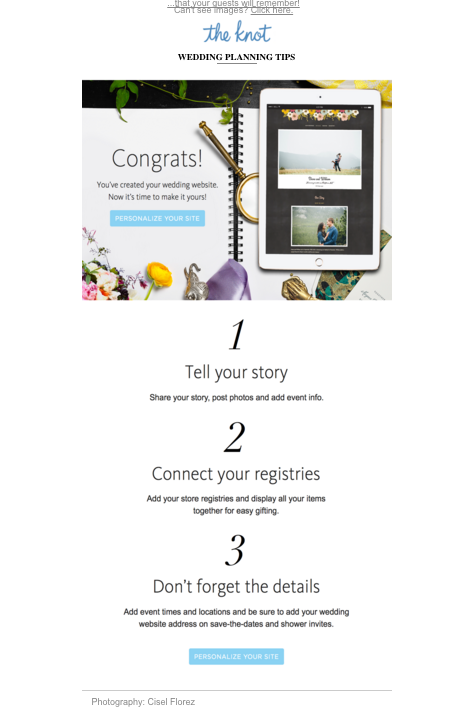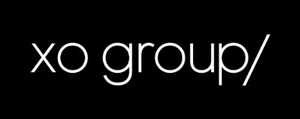UNBOXING: XO Group
This week we interview Sara Ezrin Larsen, XO Group’s Vice President of Product Marketing and long time Only Influencers member, about XO Group’s email marketing program:
Can you give us some background on XO Group and the brands you represent?
 The XO Group, Inc. is the parent group to 3 lifestage brands: The Knot, The Nest, and the Bump. I primarily focus on The Knot - the leading wedding website. Our mission is to inspire, plan and book every wedding in America. The Knot is in the midst of an exciting transition from a traditional media site, to a wedding planning marketplace. The transition started in 2015 with the launch of a personalized venue concierge booking service. Since then we have added a hotel “room block” booking service, tuxedo rental service, and more. It is a very exciting time.
The XO Group, Inc. is the parent group to 3 lifestage brands: The Knot, The Nest, and the Bump. I primarily focus on The Knot - the leading wedding website. Our mission is to inspire, plan and book every wedding in America. The Knot is in the midst of an exciting transition from a traditional media site, to a wedding planning marketplace. The transition started in 2015 with the launch of a personalized venue concierge booking service. Since then we have added a hotel “room block” booking service, tuxedo rental service, and more. It is a very exciting time.
I’m the Vice President of Product Marketing. I manage a consumer marketing team of two, a director and associate, who manage our product campaigns, paid media, and our content marketing efforts. I also manage our email marketing and operations team. The email team has an email marketing manager and three email associates.
Let’s start at the beginning and talk about acquisition. How do you go about growing your list?
Acquisition has been huge topic of conversation on our end since moving towards a transactional website for The Knot in March of 2105. Prior to that transition, everything on the site was gated. If you wanted to read an article or use one of our planning tools, you had to sign up on The Knot and opt in for email. Last March, we moved to an un-gated sign up and the results were interesting. We anticipated a very large decrease in sign-ups. The rate of sign ups only dropped 15% on average.
However, we did see that the number of invalid email addresses signing up increased significantly. This had a larger impact on the success of our email performance metrics and email traffic. We are in the process of rolling out acquisition tactics to capture email addresses such as sign up on social, interstitials on our site, etc.
Do you do any kind of email validation on the website?
We do now. When I got here a little over a year ago, we were only validating that email addresses contained an @ sign and a valid domain extension. When we launched the new site, I started tracking a high increase in the bounce rate on our real-time email sign up confirmation. We have since added in basic syntax validation. We also implemented “type ahead” where, as a person enters an email address it will ‘drop down’ the most recent email address they input into a form. The “type ahead” had an amazing impact. We were having a 20% bounce rate on that trigger email. The bounce rate decreased from 20% to 5-7%. We are now working on integrating Kickbox.io for more robust email validation.
 Can you talk a bit about what the consumer experiences with your program? What is the cadence of your email campaigns like?
Can you talk a bit about what the consumer experiences with your program? What is the cadence of your email campaigns like?
This is where you can really see the impact of the transition on our email marketing. The email marketing program prior to March 2015 was entirely monetized by advertisers. More than 50% of the emails we send out on a weekly basis are dedicated advertiser and ecommerce emails. We also have editorial emails and targeted planning emails. We are moving towards more planning related email marketing and content marketing. The transition is slow but it is in progress.
I think we could do a better job from a personalization and targeting perspective but because of our advertiser responsibilities we are somewhat limited in that area. As we move to an actual marketplace, our goal is to migrate to more behavioral triggers based on user actions. We are layering those in now in some specific areas but not across the board due to our overall frequency.
For advertising based emails, do you provide the content, or does the advertiser?
We offer both services. Custom content is a growing area for us. Right now, the majority of the email content comes directly from the advertiser.
As we make the transition from media to marketplace, one of the biggest challenges that we discuss daily is: How do you create the most value and the best experience for the user while still satisfying the advertiser? Our email program definitely reflects that challenge.
We are working on a number of efforts to create more behavioral segmentation for our advertisers to prove the value of targeted emails versus focusing just on reach. We are piloting a couple of efforts using behavioral and demographic targeting with a few clients.
We have also started testing a few different approaches for advertisers including content marketing to position the advertiser in a more relevant context. My goal is to increase our engagement metrics so that the advertiser is still happy with the how they are performing and the users are happy and not unsubscribing.
As you know, we are producing the Email Innovations Summit next month so I’m always interested in the types of technologies brands are using. What are the technologies you are currently looking at?
One of the things I’ve been looking at are technologies that enable actions within the email that can trigger an API and update the user’s status across channels. For example, you could have a call to action in your email, such as “add this to your cart” or check off a wedding checklist “to-do” such as finding your wedding venue or your wedding photographer. I want our customers to take that action right in the email and populate across the website and the app.
One of the biggest challenges that any email marketer faces is getting buy-in at that top. Can you talk about the process of getting buy-in at XO Group?
My approach is to start with gathering the appropriate data analysis, such as of trend analysis on engagement metrics, unsubscribes, and bounces in the case of email. Second step is to forecast the impact that any increase or decrease will have on revenue. I will typically then review my presentation with the various business leaders to get their questions and feedback.
I spend a lot of time looking at inbox metrics, specifically the delete-without-read rate. This has been one the most powerful data points. 50% of our list are gmail.com addresses. I was able to correlate high delete-without-read rates to poor engagement on advertiser emails to forecast the impact on revenue that would be at risk. This really opened the eyes of our executive team to get buy in for more changes to our email practices.


